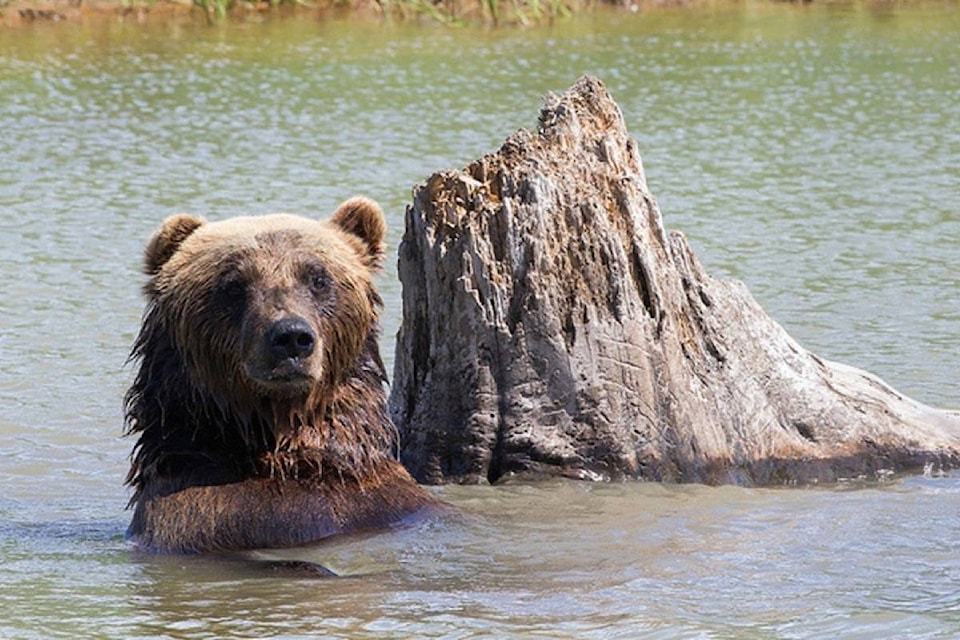The B.C. government has not effectively managed grizzly bear populations in the area north of Grand Forks because of potential costs to the forest industry, according to a report released by Thursday morning.
The Friends and Residents of the North Fork (FRNF) is a group of “concerned citizens” that filed a complaint with the Forest Practices Board in July 2015 alleging that the government was not protecting grizzly habitat in the Kettle-Granby.
The ensuing investigation sparked a report that concluded the provincial government has failed to effectively manage the risk posed to bears by forestry roads in the Kettle-Granby. The Forest Practices Board is an independent forestry watchdog that conducts investigations and makes recommendations to government on forestry issues.
“We found that government did not make road density targets a legal requirement in GAR [Government Action Regulation] Order 8-373, due to industry concerns about increased delivered wood costs,” reads the report. “Government did not complete several planning initiatives and licensees did not implement the road density targets because they were not a legal requirement.”
GAR Order 8-373 is a wildlife measures order for the grizzly bear population in the Boundary Forest District signed in August 2010.
“As road density increases in the specified area, the grizzly bear population will be at greater risk. However, what is missing is a grizzly bear recovery strategy for this population. In the absence of such a strategy, there is little to guide management and operational decisions,” the report continues.
According to the board, the grizzly population in the Kettle-Granby has been a concern since the 1990s, and although it has stabilized or grown in the last 20 years, is still threatened.
A statement from the Ministry of Forests, Lands and Natural Resources states that the grizzly bear population in the Kettle-Granby has increased according to a survey done in 2015.
However, members of the Friends and Residents of the North Fork group note that claim is misleading - the population has increased by only one bear.
Margaret Steele and Roy Schiesser are two members of FRNF. They say they filed the complaint in July 2015 after working on the issue of grizzly populations for 20 years. While the initial concern was about grizzly populations in general, the main concern has now become how froest roads impact grizzly habitat and population.
Since FRNF filed the complaint in 2015, forestry roads have continued to be built and now “nearly the whole” of the grizzlies’ habitat is roaded, Steele said.
In the 2010 GAR order, Steele said, government advisers and biologists recommended that road density not exceed 0.6 kilometres per kilometre squared. As a result of the lack of legal requirement, road density has continued to increase, she added.
“The thrust of our complaint was that the GAR order for this area did not include the legal requirement to reduce roads and roads are the number one threat to grizzlies,” Steele said.
The ministry statement also said that the board report did not the full impact of the order.
“The Board did not investigate the effectiveness of the order, but rather focused on non-legal aspects of the order,” said the statement. The ministry said they would response to the recommendations as requested.
According to the board report, the grizzly population in the Kettle-Granby is estimated to be at half of what the area could support.
Forest Practices Board chair Tim Ryan said research has shown that in areas were road density is limited, there is a higher grizzly population.
“Government chose to rely on forest professionals and forest licensees to voluntarily reduce the amount of forestry road in the Kettle-Granby area, rather than making it a legal requirement, but that did not happen,” said Ryan in the report. “It’s time for government to revisit its approach to management of this threatened bear population, implement an access management planning process, and consider the use of legal tools.”
The report included four recommendations for the provincial government moving forward. Those included the development of a strategy with a population target, revisiting the 2010 wildlife order for the area, and lead licensees and BC Timber Sales in planning which includes road deactivation and closures.
Schiesser said the ideal outcome as a result of this report is that industry in the area, and across the province, starts to decommission roads.
“We hope they will realize that this is important and that they do have an obligation to protect this sub-population and have legislation and enforce it so industry across the province will have to make sure that they bring their road densities down to that acceptable level wherever there are grizzly populations,” he said. Steele and Schiesser both noted that in decommissioning roads they meant more had to be done besides installing gates; roads had to be obliterated and allowed to return to a natural state.
“Many people suggest putting gates to limit access. Access is the problem … we want to see the road beds obliterated and natural contours restored so that there can be no motorized access in those areas. Not every road, but to bring density down,” Steele said. This is commonly done on temporary roads, Steele noted.
By having so much human and motorized access via forest roads, Steele said, the grizzly habitat was becoming fragmented and putting the bears at risk from interactions with humans.
Requests for comment from BC Timber Sales had not been returned at press time.
MLA Linda Larson said she was certainly open to beginning the discussions around the grizzly habitat and wanted to have discussions with stakeholders at the table.
“The next step is the decommissioning of those roads and that is a decision that has to be made by . .. anyone involved in [the use of the roads],” she said. “I would support the conversation. You have to put the right people at the table.”
The board is requesting a response from the Ministry of Forests, Lands and Natural Resources by Dec. 15, 2017.
